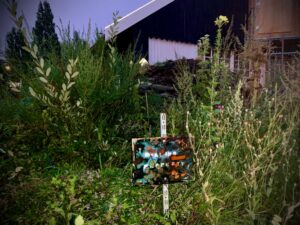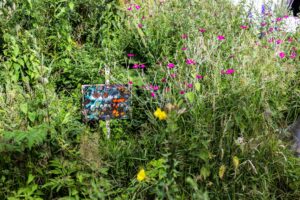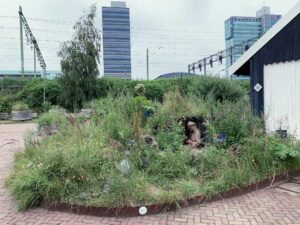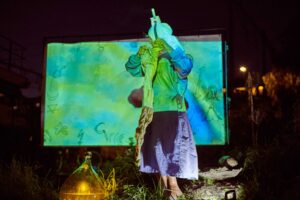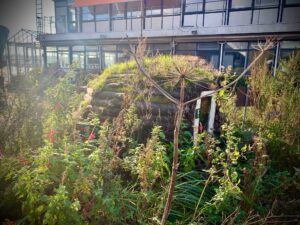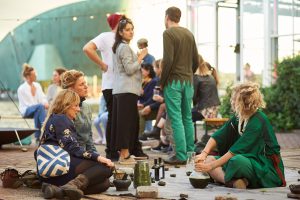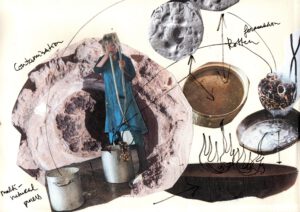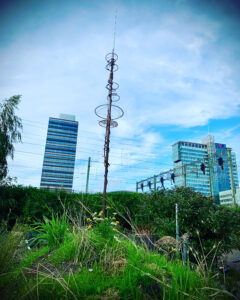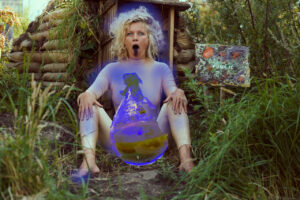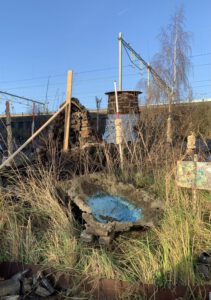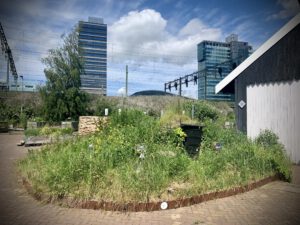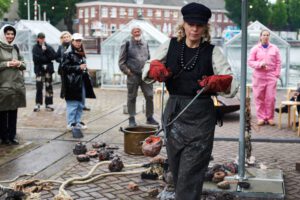TUMULUS
TUMULUS: Wild growth garden mound/ornamental hermit hut/woad plantation/ living sculpture/fermentation lab, Mediamatic Biotope, central Amsterdam.
In the early summer of 2019, Noorda began work on Tumulus, a multi-year wild growth garden mound, sculpture and performance space sited by the Dike Canal at the Mediamatic Biotope. Ground was broken for this bio-based celebration of seasonality, weed-and-fermentation power in June. The project’s timeline is laid out below:
1. Promised Land (June ‘19) – Assigned an area used in 2015 as a burial site for Mediamatic’s freshly disassembled loam-and-straw office, and afterwards as a demonstration patch for fermentation projects, Ruchama prepares the ground by hammering an iron ring into the brick pavers encircling the Tumulus mound.

2. Vegetative State (June 15th – July 15th ‘19) – Next, she scatters woad seeds (isatis tinctoria) among the other weeds and wildflowers growing on the mound.

3. Growth Imperative (July – October ‘19) – On the afternoon of Friday, September 13th, Ruchama conducts a ceremony to inaugurate the project. Afterwards, visitors gathered round a campfire are offered cups of handcrafted absinthe and Ruchama’s detox nettle tea – libations brewed from ingredients harvested on-site from the Tumulus mound,

4. Dormant Lot (Nov ’19 – Feb ‘20)

5. Healing Property-Hermit Hut I (Mar – Aug ‘20). The mound wakes up, the weeds spring back, and flourish through the summer. Assisted by a team of volunteers, Ruchama builds an ornamental hermitage using compacted earth and salvaged construction debris abandoned on the streets in the first phase of the Covid-19 home-improvement boom. The hut is mounted at the centre of the mound, slightly sunk into the earth


6. Blue Monday (Sept 21st, 2020) In early September, Ruchama harvests the woad planted the previous year to make root, leaf and seed medications and prepare a batch of dye (4). Following the age-old woad dye recipe, she places bunches of the plant in a flat-bottomed flask, adds urine, and leaves the mixture to ferment. On the night of September 21st, Ruchama stages a performance to mark the passage of the seasons through the equinox when the sun hangs for a day directly over the equator. Shuffling backwards through the Tarot pack in a triple-layered costume, she appears first as the hooded Abbess-Reaper armed with a scythe, harvesting the herbs in the infirmary garden. Next, casting off the hood, she morphs into the Nurse-Nun-Hierophant dressed in a surgical mask and blue surgical gloves with a smoking phylactery tied to her head. Finally, stripped down to a leotard, a raw Novitiate once again, starting out on her journey, she merges with her Second Life projection looping on the video screen and crawls up the slope back inside the grotto through the hut’s open door. The turning point of Blue Monday happens at the mid-point as RN pours the woad-and-urine brew onto a square of fabric and holds it up to the light as, instantly oxidizing, it turns from white to blue.

7. Hibernating Winter Garden (Dec ‘20- Mar ’21)


8. Spring (Mar- Jun ’21) The hermit hut door, now painted with wood tar is a solid black square hemmed in on all sides by a tangle of green and the bright yellow flowering woad.
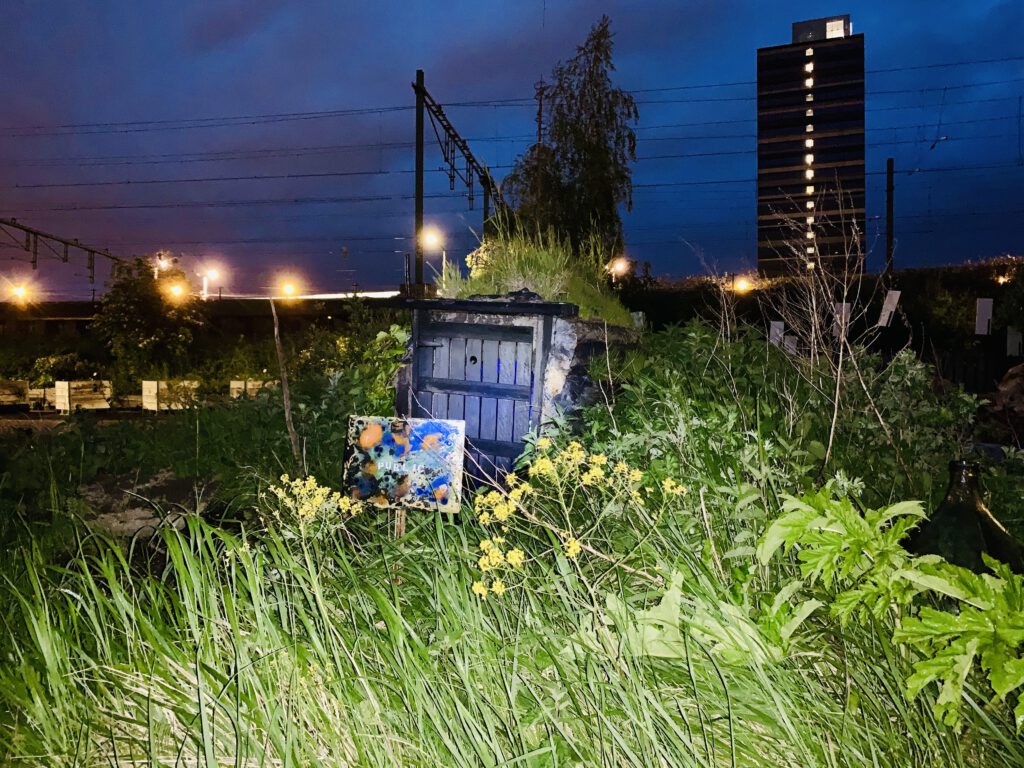
9. Firing/Ferment (June ’21)
In June, Ruchama begins shaping and firing rough knuckles in clay, threading the pieces on rebar and lengths of nautical hemp rope coated with wood tar and linking them together in a line encircling the hut. She begins experimenting with low-fire kiln processes, raku firing methods, and techniques for making fermented glazes.

Ferment (Sept ’21)
In this phase of the project, Ruchama foregrounds fermentation as a living microorganic agent in the brewing of the glazes she uses to coat the ceramic works clustered round the hut. The glaze combines the four composite ingredients- sugar, yeast, flour and water- that stand at the beginning of agrarian civilization and today may augur its downfall.

For thousands of years through the magic of mutual contamination, the ebullient sugar/yeast/flour/ water brew has facilitated the explosive growth of human populations through the reliable delivery of dietary staples like bread and beer.

In Claude Levi-Strauss’s culinary triangle, the crucial third category mediating between nature (the Raw) and culture (the Cooked) is the Rotten – the process of ‘natural’ decomposition whereby biodegraded foodstuffs (e.g. cheese, pickles, sauerkraut, kimchi, kombucha, miso) get broken down by enzymes produced by living organisms.
In the current ferment in which we find ourselves today when the fundamental viability of our collective way of life is on all sides placed in question, the rotten can function both as symptom and as cure. Noorda’s work has both- both grieving and the possibility of redemption– the bony ceramics threaded like totems or bits of bread on scaffold poles, the hermit hut with the unclosed door, an acknowledgement of necessary limits and open endings
10.Tumulus Hut II: Ruin (Dec ’21)


Living Ruin (Feb ’23)
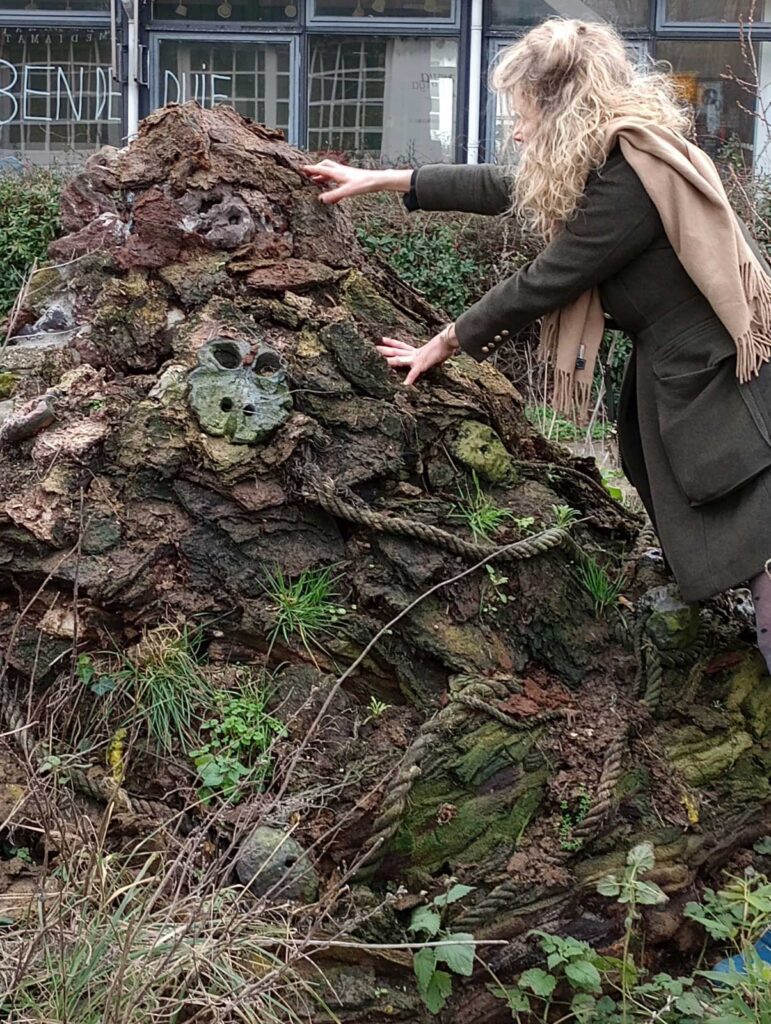

TUMULUS: Wild growth garden mound/’natural’ ruin/living sculpture-earthwork /weed bed-woad plantation/ fermentation lab sited by the Dike’s canal at the Mediamatic Biotope in central Amsterdam, the Netherlands, June 2019 – February 2023.
https://www.mediamatic.net/en/page/374473/tumulus
https://publiekewerken.ruchama.com/





